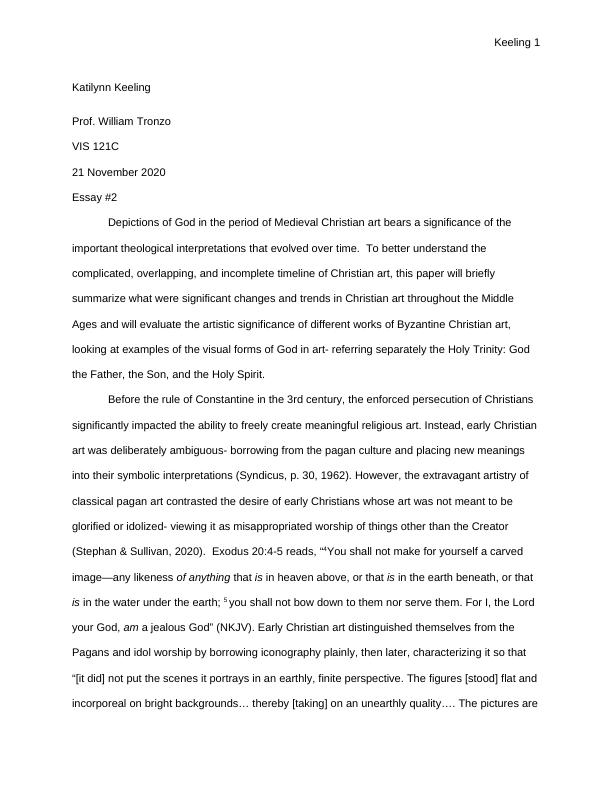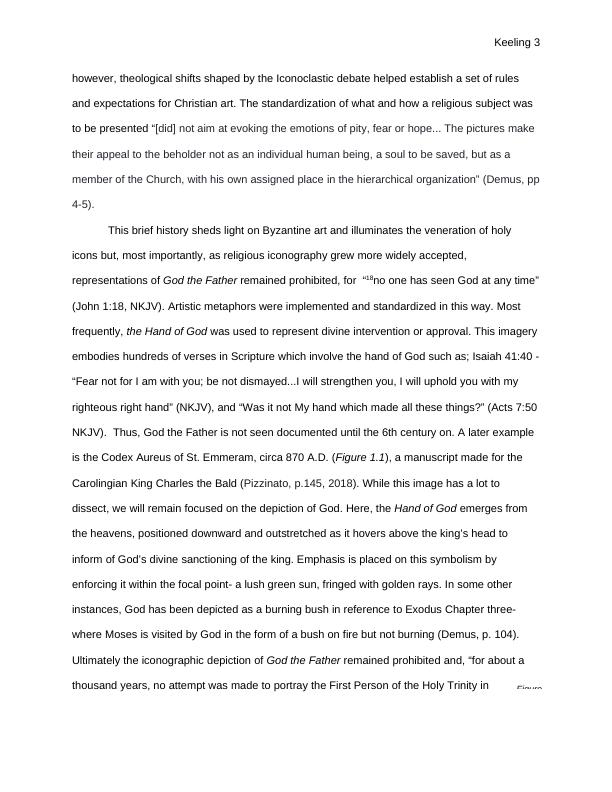Ask a question from expert
Early Christian Art - Essay
10 Pages2773 Words341 Views
Added on 2020-12-07
Early Christian Art - Essay
Added on 2020-12-07
BookmarkShareRelated Documents
Keeling 1Katilynn KeelingProf. William TronzoVIS 121C21 November 2020Essay #2Depictions of God in the period of Medieval Christian art bears a significance of the important theological interpretations that evolved over time. To better understand the complicated, overlapping, and incomplete timeline of Christian art, this paper will briefly summarize what were significant changes and trends in Christian art throughout the Middle Ages and will evaluate the artistic significance of different works of Byzantine Christian art, looking at examples of the visual forms of God in art- referring separately the Holy Trinity: God the Father, the Son, and the Holy Spirit. Before the rule of Constantine in the 3rd century, the enforced persecution of Christians significantly impacted the ability to freely create meaningful religious art. Instead, early Christianart was deliberately ambiguous- borrowing from the pagan culture and placing new meanings into their symbolic interpretations (Syndicus, p. 30, 1962). However, the extravagant artistry of classical pagan art contrasted the desire of early Christians whose art was not meant to be glorified or idolized- viewing it as misappropriated worship of things other than the Creator (Stephan & Sullivan, 2020). Exodus 20:4-5 reads, “4You shall not make for yourself a carved image—any likeness of anything that is in heaven above, or that is in the earth beneath, or that is in the water under the earth; 5 you shall not bow down to them nor serve them. For I, the Lord your God, am a jealous God” (NKJV). Early Christian art distinguished themselves from the Pagans and idol worship by borrowing iconography plainly, then later, characterizing it so that “[it did] not put the scenes it portrays in an earthly, finite perspective. The figures [stood] flat andincorporeal on bright backgrounds... thereby [taking] on an unearthly quality.... The pictures are

Keeling 2signposts, informative rather than beautiful...” (Syndicus, p 30, 1962). Holy representations, therefore, were mostly limited to abstraction and portrayals of artistic metaphors and symbols that called on followers to interact with the meanings behind the icons, rather than to idolize the representation of the icons themselves...By the late 2nd Century, incipient pictorial art began to make an appearance. It is important to note that the ‘starting point’ of Christian pictorial art-“lies in the basic teaching of the Christian revelation itself- namely, the incarnation, the point at which the Christian proclamation is different from Judaism. The incarnation of the Son of man, the Messiah, in the form of a humanbeing- who was created in the “image of God”- granted theological approval of a sort to use the images that symbolized Christan truths” (Stephan & Sullivan).The 4th Century became marked by Constantine’s support and legalization of Christianity, freeing them from religious persecution. The Church grew (wealthier), and theological perspectives pushed Christian iconographic art to become more widely accepted as it symbolized testament to the faith, rather than seen as iconographic representations to be worshipped. Narrative-based art could now be freely made according to Christianity (though borrowed pagan icons/symbols were now fixed into Christian symbolism) and individual portraitsof Jesus originated and grew more elaborate.Christian art expanded over the 6th and 7th Centuries and ushered in the First Golden Age of Byzantine art (Demus, p. xiv, 1955). Magnificent churches were erected and lavishly decorated with religious art which “served as spiritual gateways” (Hurst, 2004). However, the 8thand 9th centuries became notably defined as the Byzantine Iconoclastic Period, in which social and political upheavals, led by Emperor Leo III (and his later successor), divided the Orthodox church regarding theological interpretations of the Old Testament Ten Commandments which forbade the worship of “graven images” (“Iconoclastic Controversy”). The Church remained mostly in support of religious iconographic art throughout these periods of divisiveness;

Keeling 3however, theological shifts shaped by the Iconoclastic debate helped establish a set of rules and expectations for Christian art. The standardization of what and how a religious subject was to be presented “[did] not aim at evoking the emotions of pity, fear or hope... The pictures make their appeal to the beholder not as an individual human being, a soul to be saved, but as a member of the Church, with his own assigned place in the hierarchical organization” (Demus, pp4-5). This brief history sheds light on Byzantine art and illuminates the veneration of holy icons but, most importantly, as religious iconography grew more widely accepted, representations of God the Father remained prohibited, for “18no one has seen God at any time”(John 1:18, NKJV). Artistic metaphors were implemented and standardized in this way. Most frequently, the Hand of God was used to represent divine intervention or approval. This imageryembodies hundreds of verses in Scripture which involve the hand of God such as; Isaiah 41:40 -“Fear not for I am with you; be not dismayed...I will strengthen you, I will uphold you with my righteous right hand” (NKJV), and “Was it not My hand which made all these things?” (Acts 7:50NKJV). Thus, God the Father is not seen documented until the 6th century on. A later example is the Codex Aureus of St. Emmeram, circa 870 A.D. (Figure 1.1), a manuscript made for the Carolingian King Charles the Bald (Pizzinato, p.145, 2018). While this image has a lot to dissect, we will remain focused on the depiction of God. Here, the Hand of God emerges from the heavens, positioned downward and outstretched as it hovers above the king’s head to inform of God’s divine sanctioning of the king. Emphasis is placed on this symbolism by enforcing it within the focal point- a lush green sun, fringed with golden rays. In some other instances, God has been depicted as a burning bush in reference to Exodus Chapter three- where Moses is visited by God in the form of a bush on fire but not burning (Demus, p. 104). Ultimately the iconographic depiction of God the Father remained prohibited and, “for about a thousand years, no attempt was made to portray the First Person of the Holy Trinity inFigure

End of preview
Want to access all the pages? Upload your documents or become a member.